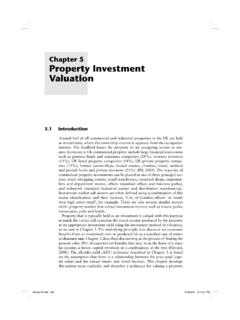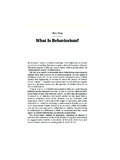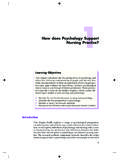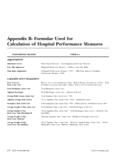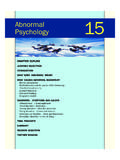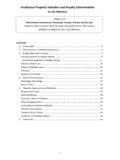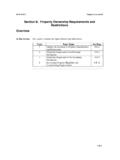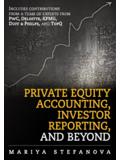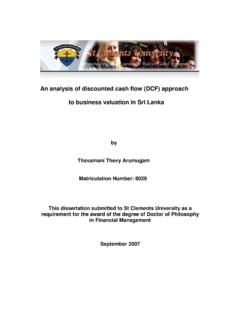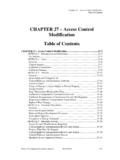Transcription of Part Two Market Valuation Models - Wiley-Blackwell
1 part TwoMarket Valuation 898/18/2007 12:51:34 PM8/18/2007 12:51:34 908/18/2007 12:51:34 PM8/18/2007 12:51:34 PMPart IntroductionThe basis of accepted techniques for the appraisal of property investments evolves from the attitudes and perceptions of those who carry out the appraisals and those who own and occupy the properties being appraised. Their influences range from the concepts and techniques taught to them in the formative years of their careers to the Market conditions that apply at the time of the Valuation and their perceptions of future changes in those will also be influenced by the role of the appraisal.
2 In the UK, valu-ation usually requires the assessment of an exchange value or Market value. Valuations are used in place of the pricing mechanism present in securities markets; and it is only relatively recently that other types of value and Valuation have been discussed in detail. part Two of this book therefore deals exclusively with the assessment of Market value and critically reviews the approach that has evolved in the UK over a considerable number of years. Valuation has been the principal focus of the main professional insti-tution dealing with real estate in the UK, the Royal Institution of Chartered Surveyors (RICS).
3 However, for a long time Valuation was seen as a tech-nical subject to be learnt and passed on from practitioner to practitioner. Although there were a few full-time educational courses in the UK, it was only from the 1970s onwards that real estate became a mainstream degree subject in a number of universities and more academic principles were brought to bear upon the topic. The original interest in Valuation as a more theoretical discipline was initi-ated by the property crash of 1973. The more violent falls in value in 1990 gave renewed impetus to the call for valuers to modernise their methods and create a defensible, rational approach.
4 This chapter reviews the evolution of Chapter 4 The Theory and Practice of Conventional Appraisal 918/18/2007 12:51:35 PM8/18/2007 12:51:35 PM92 property investment Appraisalthe conventional Valuation technique (examined in greater detail in the first and second editions of this book), sets out the basic approaches currently adopted by practitioners and critically examines their The evolution of conventional techniques The changing perception of investorsThe conventional techniques for assessing Market value have evolved over a significant time period and have been adapted and amended as circum-stances change.
5 Although Trott (1980: 1) suggested that for many decades the conventional methods of investment Valuation were accepted as logical, practical and seemingly immutable , this was re-examined and shown to be untrue, in the UK at least, in the years that followed, with our first edition detailing the criticisms in book form for the first time. Techniques can be seen to bend and change as markets evolve. It is there-fore virtually impossible to understand the details of Valuation methods without an examination of how these methods evolved, and without con-sidering the context within which the changes took place.
6 In the first edi-tion, a detailed examination of how Valuation techniques evolved during the twentieth century was undertaken. This examination was based upon pri-mary research into the behaviour of property values in central Nottingham, a major urban centre in the UK (Crosby, 1985), and a review of the basic textbooks of the economic context of the model remained virtually unchanged until the 1960s. The key issue explaining this was the absence of inflation and more importantly expectations of inflation (and therefore rental growth) until the late 1950s.
7 In the first edition, we showed that basic economic indicators suggested that there was no or little perception of the damage inflation could cause to investment returns, if it was not specifically included in pricing Models ; and as a result it was not explicitly included in those Models . Table sets out a number of local property Market indicators for Nottingham City Centre retail, a provincial city situated in the East Midlands region of the UK. This shows that rental values grew by about times between 1910 and 1946 and that inflation was also almost exactly the same, growing by times in the same period.
8 This represents an annual growth rate of The average yield on government bonds was , giving a real return of virtually zero. At the same time property capitalisation rates for retail properties, which were also growing in value at approximately the inflation rate, averaged (a 2% risk premium over gilts). An annual rent review structure would have enabled property investors to obtain returns of over 9%, a risk premium above gilts of But this part 928/18/2007 12:51:35 PM8/18/2007 12:51:35 PMConventional Appraisal Techniques 93 Table Nottingham City Centre, retail property , rents, infl ation and initial yields, 1910 Prime rentAverage rent index (2)Retail prices index (RPI) (3)Prime initial yields (4)Gilts (5) 1910 = 1001946 = 1001910 = 1001946 = 1001913 = 100 938/18/2007 12:51:35 PM8/18/2007 12:51.
9 35 PM94 property investment Appraisalopportunity was spurned by property investors, whose fixation with security of income appeared to override their desire for return, as they attempted to tie tenants to very long leases without rent revision. Leases of 21, 42 and 63 years with no or very infrequent rent reviews were not uncommon for good-quality retail tenants in good locations, and this practice turned property into a fixed-income bond investment with a 2% risk premium over gilts. The obvious question to ask is: why, in the face of such basic evidence, did investors still invest in bonds, which were giving no real returns, and turn property investments an opportunity to hedge against inflation into another form of fixed-income bond?
10 Crosby (1985) concluded that investors had not recognised the harmful effects of inflation on fixed incomes because of the cyclical nature of the inflation and the numerous shocks that had occurred in the first half of the twentieth century. These shocks may have been seen as the only cause of inflation, and investors assumed that it was not the natural state of affairs. The great war of 1914 1918 had seen prices double, while in the 1920s they fell by well over one-third. During World War II prices again rose by over a third.
